

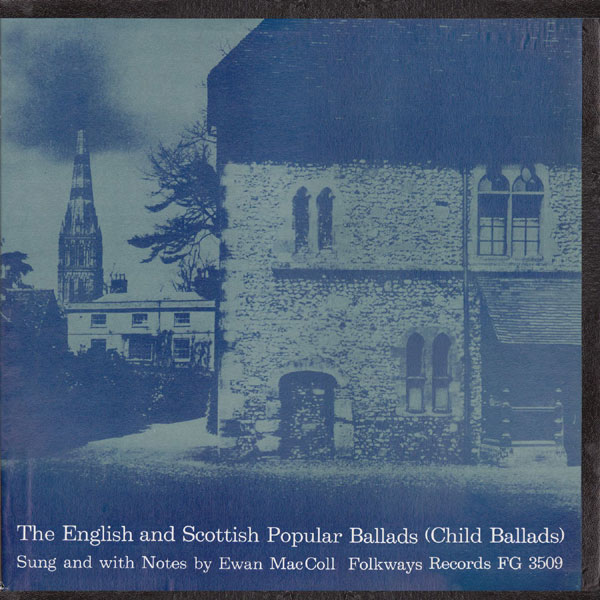 |
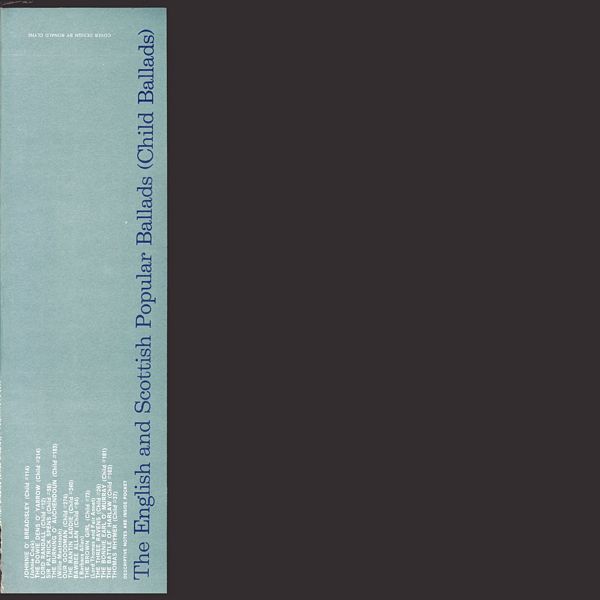
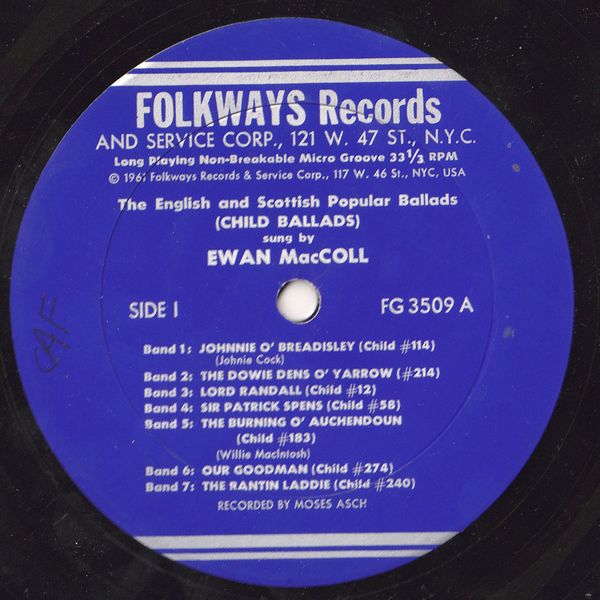
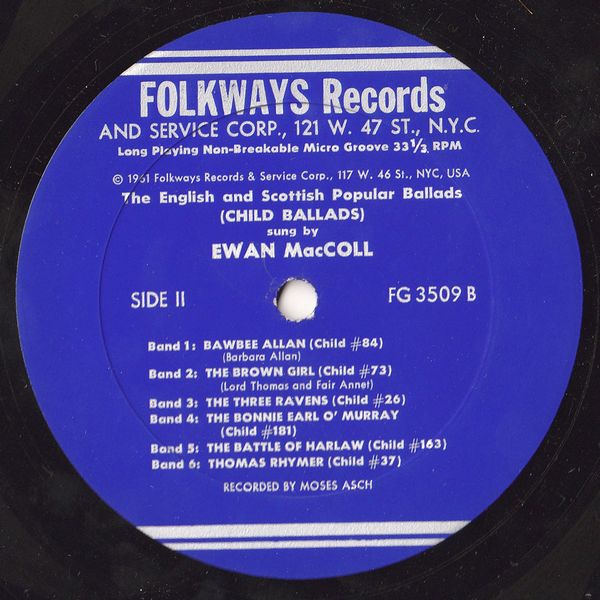
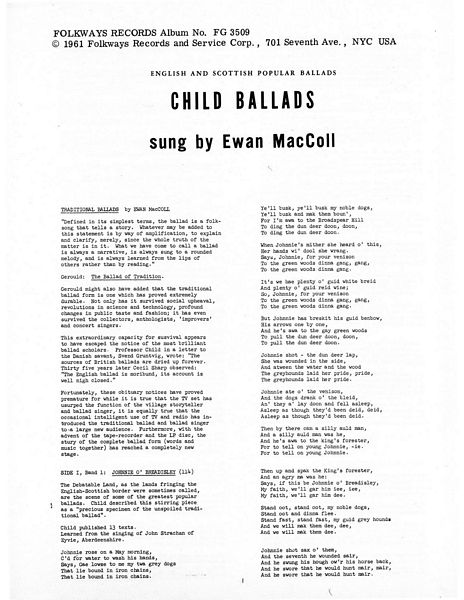 |
Sleeve Notes
TRADITIONAL BALLADS by EWAN MacCOLL
"Defined in its simplest terms, the ballad is a folksong that tells a story. Whatever may be added to this statement is by way of amplification, to explain and clarify, merely, since the whole truth of the matter is in it. What we have come to call a ballad is always a narrative, is always sung to a rounded melody, and is always learned from the lips of others rather than by reading."
Gerould: The Ballad of Tradition.
Gerould might also have added that the traditional ballad form is one which has proved extremely durable. Not only has it survived social upheaval, revolutions in science and technology, profound changes in public taste and fashion; it has even survived the collectors, anthologists, 'improvers' and concert singers.
This extraordinary capacity for survival appears to have escaped the notice of the most brilliant ballad scholars. Professor Child in a letter to the Danish savant, Svend Gruntvig, wrote: "The sources of British ballads are dried up forever." Thirty five years later Cecil Sharp observed: "The English ballad is moribund, its account is well nigh closed."
Fortunately, these obituary notices have proved premature for while it is true that the TV set has usurped the function of the village storyteller and ballad singer, it is equally true that the occasional intelligent use of TV and radio has introduced the traditional ballad and ballad singer to a large new audience. Furthermore, with the advent of the tape-recorder and the LP disc, the story of the complete ballad form (words and music together) has reached a completely new stage.
Johnnie O' Breadisley (114) The Debatable Land, as the lands fringing the English-Scottish border were sometimes called, are the scene of some of the greatest popular ballads. Child described this stirring piece as a "precious specimen of the unspoiled traditional ballad".
Child published 13 texts.
Learned from the singing of John Strachan of Eyvie, Aberdeenshire.
Dowie Dens O' Yarrow (214) Sir Walter Scott in whose Minstrelsy of the Scottish Border this tragic ballad was first published, claimed that it referred to a duel fought at the beginning of the 17th. century between John Scott of Tushielaw and Walter Scott of Thirlstane. Child and other authorities have drawn attention to the inaccuracies of this theory.
Child published 19 texts.
Learned from the singer's father.
Lord Randall (12) Known throughout Europe and America in substantially the same form, Randall is a perfect example of the question-and-answer ballad. The name of the hero varies a good deal from version to version.
Child published 15 texts.
Learned from the singer's mother.
Sir Patrick Spens (58) Motherwell has suggested that this fine ballad may be based upon the events following the marriage of Margaret, daughter of Alexander III of Scotland to Eric, King of Norway in 128l. Many of the nobles who conducted the young queen to Norway were drowned on the return voyage.
Child publishes 18 versions of this ballad.
Learned from the singer's father.
The Burning of Auchendown (183) Following the murder of the Earl of Murray, the Macintoshes of the Clan Chattan pillaged a castle and killed four men on an estate belonging to the Earl of Huntley. In retaliation, Huntley laid waste the lands of Clan Chattan. Returning home from this engagement he surprised the Macintoshes spoiling his lands at Cabrach and, in the ensuing fight, killed sixty of them.
Child published 2 texts.
Learned from the singer's father in a fragmentary form and collated with verses from Child's texts.
Our Gudeman (274) This is one of the most popular humourous ballads in the Child collection and is still fairly widespread in the Scots and English oral traditions. Child states that the Dutch, German, Scandinavian and Hungarian versions all derive from a single broadside.
Child published 2 texts.
Learned from the singer's father.
The Rantin' Laddie (240) This ballad is rare outside of Scotland, only one complete text having been reported from the United States. There appears to be no historical basis for the events described in the ballad.
Child published 4 texts.
Learned from the singer's father.
Bawbee Allan (84) This is by far the most widespread of all the traditional ballads. It has been printed in chapbooks and broadsides and, on more than one occasion, has been used as a stage song. In spite of all this, however, its oral transmission has continued to produce an incredible number of variants.
Child published 4 versions.
Learned from the sinner's mother.
Lord Thomas and Fair Annie (73) Bishop Percy included a Scots version of this fine ballad in his Reliques of Ancient English Poetry and Child described it as "one of the most beautiful of our ballads, and indeed of all ballads."
Child published 8 texts.
Learned from the singer's mother in fragmentary form and collated with stanzas in Greig's Traditional Ballads and Ballad Airs.
The Three Ravens (26) The first printed copy of this ballad is in Ravenscroft's Melismata, London 1611. In The Popular Music of the Olden Time, 1855, Chappell remarks that the ballad was still so popular in some parts of the country that he had "been favoured with a variety of copies of it, written down from memory, and all differing in some respects, both as to words and tune, but with sufficient resemblance to prove a similar origin."
Motherwell in his Minsrelsy, 1827, describes it as being "very popular in Scotland", where it is more commonly known as The Twa Corbies.
The version given here is from Kidson's Traditional Tunes, 1891, and comes from the village of Stoney-Middleton, Derbyshire.
Child published 4 texts.
The Bonnie Earl Of Murray (18l) James Stewart, Earl of Murray, was murdered by the Earl of Huntley in 1592, after having been accused of conspiring with Bothwell against the king. The death of this very popular figure provoked a public outcry, but Huntley was never punished for his part in the deed.
Child published only 2 texts of the ballad.
Learned by the singer from Private MacDonald, a soldier in the British Army, who learned it at school.
The Battle of Harlaw (163) The battle of Harlaw took place on July 24, l4ll, when an army of Highlanders led by Donald of the Isles was beaten by the Earl of Mar's Lowland forces.
Child published 2 versions.
Learned from Jeannie Robertson of Dundee.
Thomas Rymour (37) Thomas of Erceldoune, the 13th. Century poet was author of a long poem describing a visit to Elfland and the supernatural events which took place there. The poem served as a basis for the 15th. century romance which, in turn, probably provided the raw material for this ballad.
Child published 3 texts.
Learned from print.